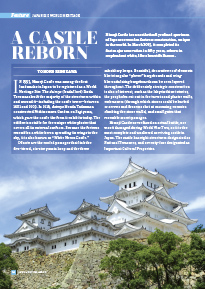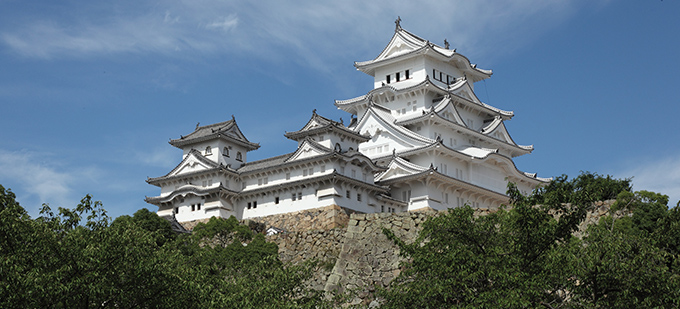Home > Highlighting JAPAN >Highlighting Japan September 2015>Japanese World Heritage
Highlighting JAPAN

Japanese World Heritage
A Castle Reborn
Himeji Castle is an aesthetically refined specimen of Japanese wooden fortress construction, unique in the world. In March 2015, it completed its first major renovation in fifty years, reborn in resplendent white, like a beautiful heron.

In 1993, Himeji Castle was among the first landmarks in Japan to be registered as a World Heritage Site. The daimyo (feudal lord) Ikeda Terumasa built the majority of the structures within and around it—including the castle tower—between 1601 and 1609. In 1618, daimyo Honda Tadamasa constructed Nishinomaru Garden on Sagiyama, which gave the castle the form it exhibits today. The edifice is notable for the unique white plaster that covers all its external surfaces. Because the fortress resembles a white heron spreading its wings to the sky, it is also known as “White Heron Castle.”
Of note are the roofed passages that link the five-tiered, six-story main keep and the three subsidiary keeps. Beautiful, decorative roof elements like triangular “plover” bargeboards and wing-like undulating bargeboards can be seen layered throughout. The deliberately strategic construction is also of interest, such as the labyrinthine interior, the peepholes cut out in the turrets and plaster walls, embrasures (through which stones could be hurled or arrows and firearms shot at oncoming enemies climbing the stone walls), and small gates that resemble secret passages.
Himeji Castle never faced an actual battle, nor was it damaged during World War Two, so it is the most complete and unaltered surviving castle in Japan. The castle has eight structures designated as National Treasures, and seventy-four designated as Important Cultural Properties.
In 2009, to ensure that this irreplaceable World Heritage Site would retain its beautiful form for the next generation, the Himeji Castle Tower Preservation and Restoration Project was begun—the first large-scale overhaul in fifty years. The façade was replastered, the roof retiled, and other restorations made in what would become a project spanning just short of six years.
Total costs reached ¥2.33 billion, and 33,000 people worked on the project (including preliminary construction). Of the approximately 75,000 roof tiles on the castle keep, 16,000 were replaced.
The process began with the construction of a temporary platform to serve as a runway for the materials and heavy machinery as well as a place to work. Of the sixty-nine months that the repairs were under way, thirty-two went to creating this platform, which was 37.6 meters tall, 66 meters long, and 10 meters wide. In spite of its gargantuan size, not a single post was put into the ground.
“Himeji Castle is a heritage property of Japan, with numerous archaeological remains on the site, so we cannot recklessly tear up the ground,” says Masaharu Kobayashi of the Himeji City Hall Education Committee, Continuing Education Division, Cultural Properties Group. “We put tarps over the ground and built a concrete foundation on top of them, then built the steel frame up from there.” After this platform was completed, they built scaffolding around the main tower, and it was only then that work on the structure itself finally began.
During the repairs, the eight-story scaffolding, named the “White Heron of the Sky,” was opened to the public, allowing visitors to tour the interior. There had never been a continuous public opening of a cultural property under repair like this before, not even in Japan. Over the two years and ten months the scaffolding was in place, 1.84 million people visited.
“We wanted people to take an interest in and develop an affinity for these cultural assets, so we opened the repair process to the public,” Kobayashi says. “Some of the artisans were apprehensive about being watched while working, but as more and more visitors came, they developed a growing pride in their work.”
The next major repairs for the main keep will be made in fifty years’ time. However, to ensure that the traditional techniques and materials are not lost, artisans are scheduled to make smaller repairs to the other towers, walkways and surrounding elements each year.
Himeji Castle has thus been restored to the glorious white of its original construction. With the repairs complete, two million visitors are expected to visit the castle this year. Visitors from abroad are on the rise each year, so the site has deployed foreign-language volunteers and a smartphone-based augmented-reality app. They are sure to enjoy the striking color contrast created by the newly resplendent facade, such as one thousand blooming pink cherry trees in the spring and the castle tower bathed in the orange glow of the setting sun.
© 2009 Cabinet Office, Government of Japan






